
A small dark brown dot, instantly and almost imperceptibly visible to the eye, disappearing from the hand that caught it. Hateful tiny vampire that causes painful bites and does not let your pet sleep. Finally, the carrier of the most dangerous diseases is all of her, a flea.
It seems that nothing in it can be interesting - a tiny parasite, which only bites and sucks blood. But why exactly did fleas become the subject of research for many scientists from around the world? Why are amateur researchers looking at microscopes with such interest and taking amazing photos?
The reason for this is one: fleas are not as simple as they seem to the average person when they first meet ...
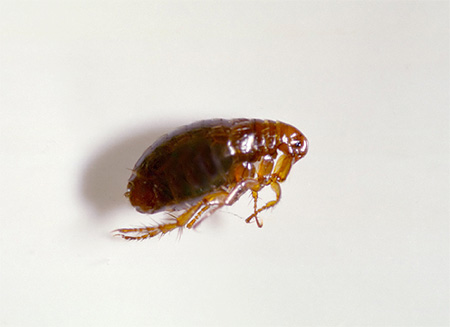
It is interesting
One of the most famous researchers for fleas was the British banker Charles Rothschild, a multimillionaire who devoted all his free time to entomology. It was he who described the southern rat flea, the former cause of many plague epidemics, it was he who collected the most complete collection of these parasites, now stored in the British Museum. Ironically, Rothschild committed suicide because he suffered from encephalitis. And it is quite possible that he picked up this disease in one of his entomological expeditions.
Some biology
The flea is a parasite in many ways unique. It is as unique as it is demanding: fleas do not bite any animals, except warm-blooded animals - birds and mammals. Only certain species are able to bite cold-blooded animals, but do so only in exceptional cases.

Of the mammals, these insects prefer those that tend to make their nests and burrows. Such habits of the owners are necessary for parasites: insects do not live on their host all the time, but only jump on it in order to suck blood. And of course, parasitizing animals that are not tied to one place, they will be great at risk of not finding a victim in the next attack of hunger.
Because fleas and prefer to settle in the holes of rodents, bird nests, dog kennels - here they are guaranteed to be able to count on a regular meal.
It is interesting
Among the huge number of flea species there are only a few dozen (up to 30) such that parasitize on nomadic animals - ungulates, hares, and cats - and therefore are constantly on their bodies so as not to lose the source of food.
With a food source, fleas eat every day. But if necessary, they can easily stretch for several months without food. But after such a fast the parasite attacks the victim with particular greed.
Thus, a person is a suitable victim for fleas. Especially the person who prefers to live in unsanitary conditions.
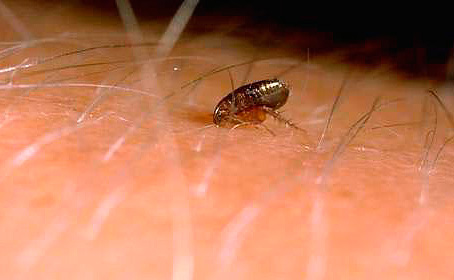
However, depending on the type of fleas may eat differently. Some are sucked into the future, so that in the excrement they remain undigested the blood of the owner. They suck from 20 minutes to an hour. Others often eat little by little - mainly those species that inhabit the nests of rodents and birds.
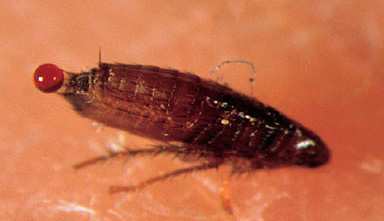
Most flea species are not tied to any one host: they can easily feed on the skin of various animals and birds. However, there are also such fleas that feed only on the blood of one animal. Usually these are obligate parasites of bats.
Fleas are distributed throughout the globe. They are even in Antarctica, meeting in the nests of birds and at the local scientific stations. The optimum temperature for their habitat and reproduction is 18-27 ° C, but at the same time the fleas can withstand rather extreme temperatures, although they stop reproducing at the same time.
It is interesting
The flea of the species Glaciopsyllus antarcticus is the southernmost insect in the world. It was found on Queen Maud’s Land and near the Antarctic stations Davis and Mawson — no other known insect is found here. This insect parasitizes on petrels and kachurks, living in the warm period of the year in the nests of these birds, and in the winter - wandering in their plumage over the oceanic expanses.
Appearance of fleas
Many people know about how fleas look, but not everyone saw the parasite in such an increase, at which you can examine in detail the body details of this small parasite.
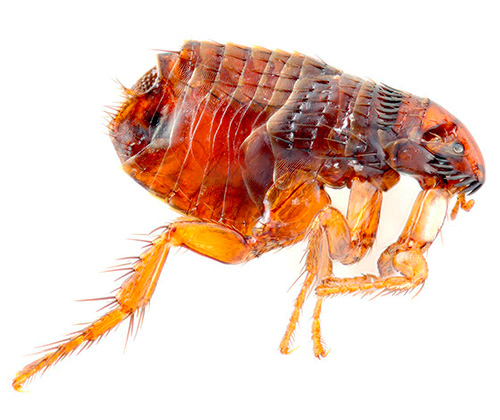
If you look at a photo of a flea taken with a microscope, you can see that its body is very flattened from the sides and looks like it was crushed. It is an evolutionary adaptation to the easy movement among the hair or feathers of the host.
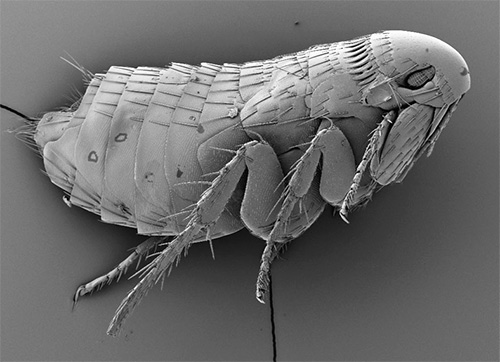
By the will of the evolutionary case, the same feature of the morphology of the insect helps it to be invulnerable when trying to comb, gnaw or simply crush the parasite with the fingers. Indeed, a person can mechanically destroy a flea only by crushing it with a fingernail on a hard surface.
The photo below shows the same flea in front and side: the difference in body proportions is clearly visible:
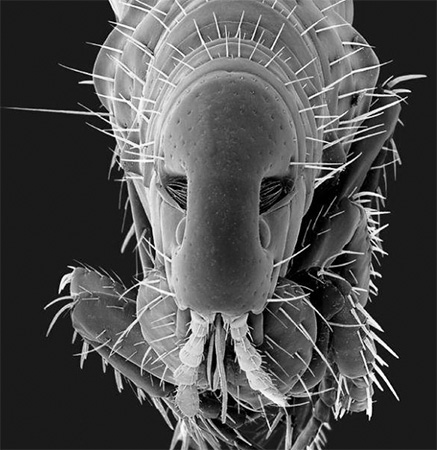
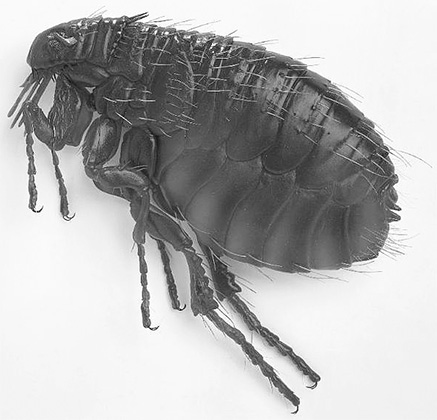
On a note
Interestingly, fossil fleas, the age of which scientists date back 50 million years ago, look almost the same as modern ones. Apparently, for such a parasitic lifestyle, such a body shape turned out to be optimal. For example, bugs and mites also have a very oblate body, only in a different direction - from top to bottom.
Photos of fleas:

Photo bed bug (body flattened in a horizontal plane):
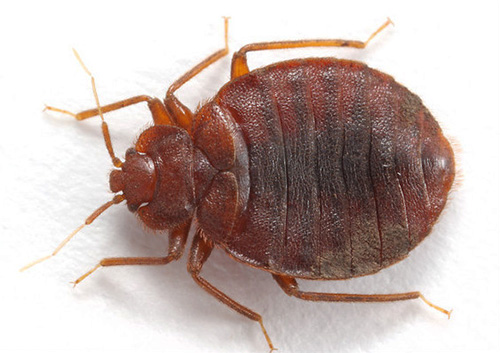
A characteristic feature of fleas are elongated hind legs. It is thanks to them that parasites can jump on almost all other insects. When feeding or in a quiet state, these legs are bent so that they do not create inconveniences for the insect to move. With elongated legs, a flea looks very original - in the photo below you can see a dog flea under a microscope:
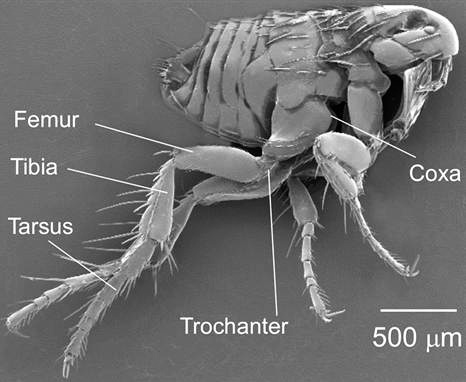
It is interesting
In relation to the distance of the jump to the body length, fleas are among the insects in second place: only one type of cicadas makes longer jumps. With a body length of 2-3 mm, the flea jumps up to 19 cm in height and up to 30 cm in length - this is 100 times the length of its body. In order for a man to compete with a flea in the range of a jump, he needs to jump at least 160 meters in length.
Long jumps to fleas provide not only strong hind legs, but also a special solid flap on the chest. When the insects bend the hind legs, this shield is pulled back like a catapult lever. And with a push, he throws up strongly, increasing the range of the jump.
On a note
Not all fleas can jump. There are those whose hind legs have the usual length and which are constantly located on the body of their host. And there is a species that, for movement between the burrows of rodents, uses as a transport ... earwigs.
All fleas are wingless. Given their way of life, the wings would be a hindrance to their movement in the host's wool. Yes, and crush a winged insect as a whole is easier than a wingless one. Evolution decided that it was better for the fleas to jump than to fly.
Fleas do not have a piercing proboscis like other blood-sucking insects - mosquitoes and bedbugs. But with their stylet-shaped jaws, they are quite costly: the upper jaws cut through the skin of the victim, and the lower ones expand the wound to inject saliva into it.
True, the feeding parasite itself has to literally immerse its body in the wound in order to reach the blood vessel - in the photo you can well see what the insect looks like at this moment:
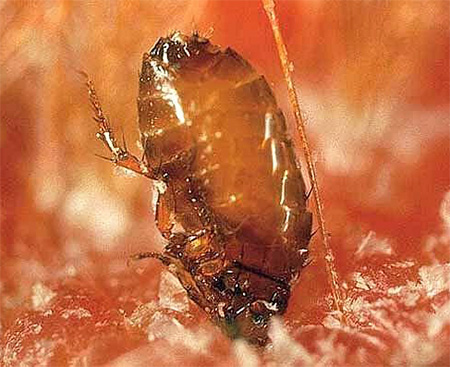
On a note
Unlike most blood-sucking parasites, fleas do not at all try to hide their bite and do not inject an anesthetic into the wound. At the same time, the enzyme contained in the insect's saliva and prevents blood from clotting causes terrible itching and the appearance of hemorrhagic edema at the site of the bite. At the same time, the portion of such an irritating substance transmitted by a single bite is negligible — only 0.000004 cubic mm. Such “arrogance” of fleas is determined precisely by their body shape: a person practically cannot destroy an insect with his fingers, and therefore the parasite does not at all try to mask its bite.
The size of the body of fleas managed to become the talk of the town: a flea is usually called someone when they want to emphasize its small size.

Indeed, the largest fleas, parasitic on elks, barely reach a length of 10 mm. Usually, fleas have a body length of 1-3 mm. Their larvae are about the same length, but they look very different than adults.
Reproduction of fleas, the appearance of their eggs and larvae
Fleas are insects with complete transformation. Their entire reproductive cycle is as follows:
- A well-fed female throws out a whole bunch of eggs: a strong pushing out of the eggs ensures a wider dispersion of them. In the photo under a microscope are presented several eggs - they are so small that it is very difficult to see them with the naked eye.
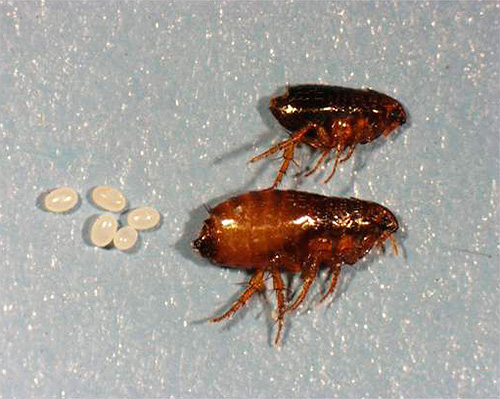
- A few days later, small white worm-like larvae emerge from the eggs, which bury themselves in the substrate on which the eggs lay. In most cases, this substrate is bedding in the nest of the host. And they can also be the old dirty carpet in the house. The larvae feed on either decaying organic matter or blood residues in the excrement of adult fleas. As the larva grows, it molts several times, and after the third molt it begins to surround itself with a thin silk cocoon, turning into a pupa.
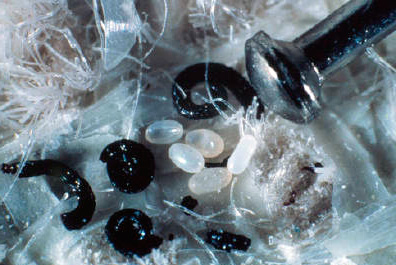
- A pupa develops for several days, and a quite adult and ready for flea parasitism comes out of it. All that remains for her is to wait for the owner and continue the work of the parents.
In a normal apartment, flea larvae can develop quite successfully in cracks in floors, behind plinths, in old carpets - in general, where there is a little bit of rotting debris.
The larva looks inconspicuous and at first glance looks like a simple little white worm. Only under a microscope in a photograph can one discern a clearly translucent filled stomach:
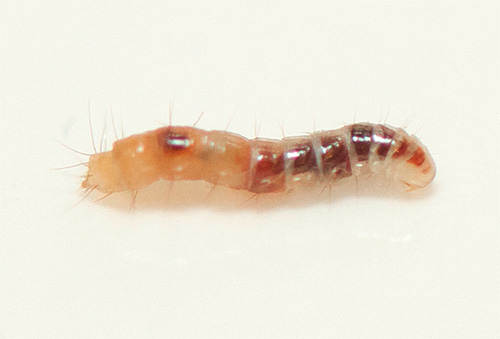
One female in her life lays up to 450 eggs, 10-15 in one portion. For one “shot,” she needs to eat well at least once. But for work in the mode of conveyor of eggs to the female it is enough one intercourse with the male.
Photos of flea eggs:
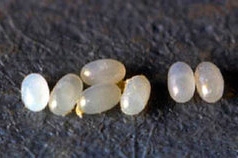
Purely theoretically, a flea can live up to one and a half years, but in real conditions it is barely up to 2 months - her way of life is too dangerous, too many of her enemies.
Types of fleas and the differences between them
There are many kinds of fleas. Scientists number more than 2000 of them, each of which specializes mainly in parasitism on one type of animal or bird. An inexperienced observer is unlikely to find a difference in how they look, and will not distinguish, for example, from rabbit flea. Experts distinguish them by such signs, which under the microscope is not very striking.
For a person, the following types of fleas are most familiar:
- human flea - indeed, there is one. It was she who was immortalized in the paintings of medieval artists, and it is about her that they say when they describe fleas in literature.
- Cat flea - The record for the number of bites of a person. It is small, very widespread and absolutely picky in choosing a host, eating well on dogs, and cats, and people.
- The rat flea, the most dangerous, is an active carrier of the causative agent of plague.
- Dog flea, relatively large and sedentary, parasitic most often on dogs.
And the list goes on and on for a very long time: barb, rabbit, elk, mouse - almost every kind of mammal has its own flea parasite.
In the photo below you can meet with representatives of the most common species.
Photo of a human flea:
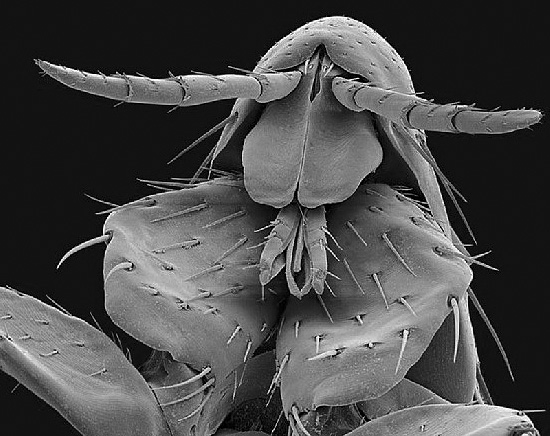
Photo of cat flea:

Photo dog flea:
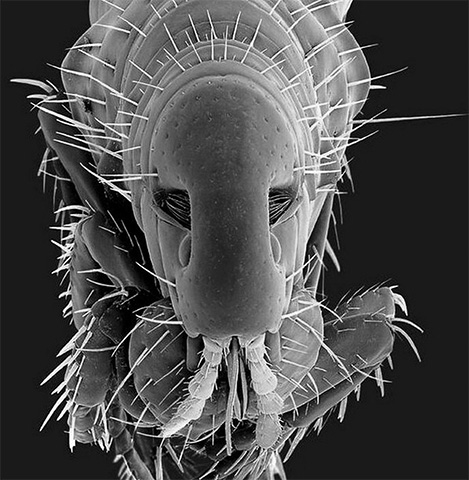
Fleas as carriers of dangerous diseases
Do not be fleas vectors of deadly human diseases, people would not have shown such efforts in their destruction. But it was these insects, along with their direct owners - rats - were the cause of the devastating epidemics of bubonic plague in Europe.Even today, many populations of rodents - jerboas, gophers, gerbils - are kept by epidemiologists under strict control, since a deadly pathogen continues to be incubated in the burrows of these animals.
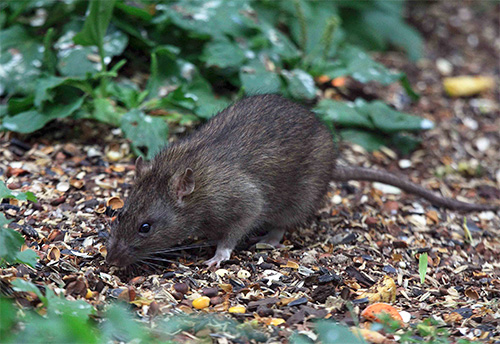
In addition to the causative agent of the plague, other bacilli and viruses actively move on the fleas:
- hepatitis A and B viruses
- salmonella
- brucellosis pathogen
- causative agent of typhoid
- encephalitis virus
- trypanosomes
- eggs of various helminths.
In total, more than 200 diseases that are dangerous to humans can tolerate certain types of fleas. And so flea bites are terrible not only by itching and redness ...
In general, it is not difficult to distinguish a flea from any other blood-sicking parasite: neither mites nor bugs have such small dimensions. And none of the six-legged vampires have the ability to jump. It is only important to examine the flea on clothes and catch them before it bites. And her identification is unlikely to become a serious problem.
An interesting video about the life of fleas

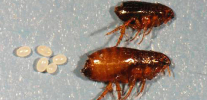
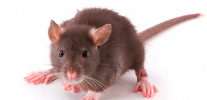

Here is a dog flea I just had to watch at the time. Fortunately, now my dog is already protected. I give him the drops of Advantix from these parasites. The main thing is that this drug does not allow an insect to bite a dog, but just the majority of drugs work through a bite.
How to get rid of them?
Here are these flea freaks ...